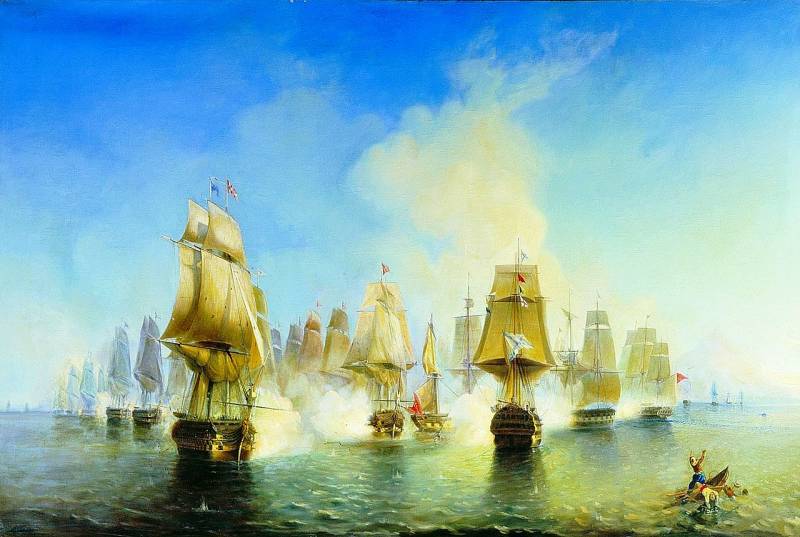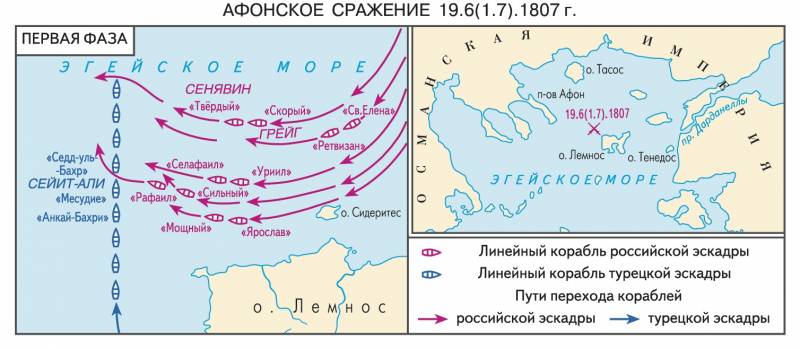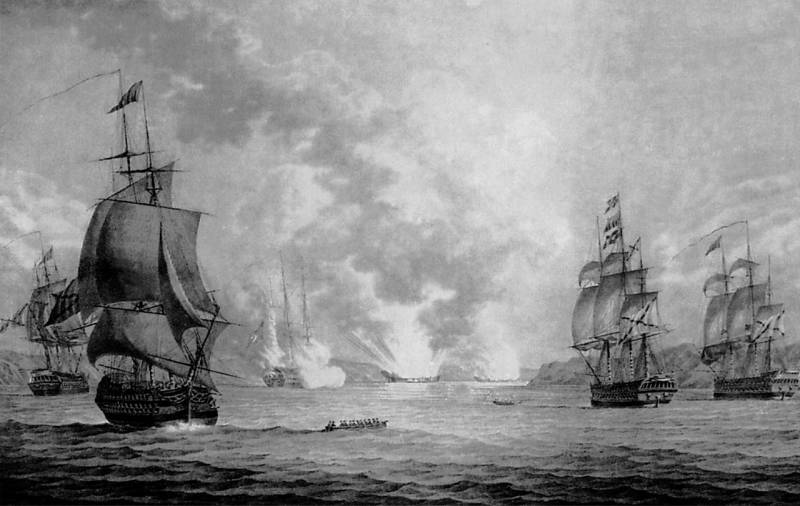How Alexander I destroyed the Russian Mediterranean fleet and gave the Archipelago province to the French

A.P. Bogolyubov "Athos Battle of 19 June 1807 of the Year"
The Turkish fleet is trying to lift the blockade
In 1807, Russia waged a bloody war with France on the territory of Prussia. Emperor Alexander Pavlovich believed that it was dangerous to wage two wars at once. He decided to offer the Porte peace and sent Pozzo di Borgo, a Corsican in the Russian service, to Constantinople for negotiations.
However, the negotiations dragged on for a number of reasons. In particular, the Janissaries rebelled in Istanbul. Sultan Selim was deposed and killed. The entourage of the new Sultan Mustafa IV wanted to continue the war.
The Turkish command again decided to try to lift the blockade from the Dardanelles (How Senyavin won a brilliant victory over the Turks at the Mediterranean theater). The Turks were going to recapture the island of Tenedos.
On June 10, 1807, the Turkish squadron of Seyid Ali Pasha left the Dardanelles - 10 battleships, 5 frigates and several small warships. Due to the constant strong northerly winds, the Russian squadron could not approach the enemy and remained near the island of Tenedos. Only on June 12 the wind became more favorable, Senyavin set out with a squadron of 10 ships and 1 frigate. Russian ships did not go directly to the enemy, but began to go around about. Imbros from the west, passing between this island and the island of Samothrace. Apparently, the Russian admiral, as earlier during the Battle of the Dardanelles, wanted to cut off the enemy from the strait.
On June 15, 1807, the Turkish fleet went to Tenedos and found here only the Bogoyavlensk brig and two small ships. Simultaneously with the approach of Turkish ships, Turkish troops began to transfer troops from the Anatolian coast. Turkish naval artillery bombarded the fortifications of Tenedos. On June 16, there were already more than 7 thousand Turkish soldiers on the island. The Russian garrison numbering 600 fighters counterattacked the enemy at the time of the landing, the artillery of the fortress and the brig fired at the enemy.
On June 17, Senyavin's squadron went to the Dardanelles and discovered the enemy, who stood between the mainland and the island of Tenedos. Our ships began approaching. The Turkish fleet did not dare to accept the battle and began to leave. The Turkish admirals wanted to divert the Russian fleet to themselves while the landing force completed the capture of the fortress. Senyavin transferred reinforcements and ammunition to the island. Russian small ships partially destroyed, partially dispersed the Turkish landing flotilla.

Athos battle
On June 18, the Russian naval commander allocated the Venus frigate, a sloop, two Greek corsairs to strengthen the defense of Tenedos, and with the rest of the ships went to search for the enemy. First, the squadron went to Imbros, and then began to descend to Lemnos. On June 19 (July 1), the Turkish fleet was found at anchor between the island of Lemnos and Mount Athos. The Russian squadron was armed with from 728 to 754 guns, the Turkish - from 1 to 138.
Before the battle, Senyavin gave instructions to break the Turkish flagships, since while they are fighting, the rest of the ships will fight hard. Therefore, each Turkish flagship was attacked by two of our ships. The Turkish squadron had four flagships: the 120-gun "Messudiyeh" ("Majesty of the Sultan") - the flagship of Kapudan Pasha Seit-Ali; 84-gun "Ankai-Bahri" ("Majesty of the Sea") - under the flag of Vice Admiral Sheremet-Bey, "Tausu Bahri" ("Sea Bird") - under the pennant of Commander Hussein Bey and "Sedd Al-Bahr" (" Stronghold of the sea") - the captain-bey of Bekir-Bey.
Turkish ships lined up. The second line included frigates, corvettes and small craft. At 7:30, Russian ships moved in pairs to the Turkish line. An hour later, the battle was in full swing. "Raphael" crossed the first enemy line and found himself between Turkish battleships and frigates. The Turkish main flagship tried to board the Raphael. The captain of the "Raphael" Lukin was killed by an enemy core.
At about 9 o'clock, Russian ships, except for the Raphael, were able to build a line and fired artillery with the enemy, concentrating fire on the flagships. At about 10 o'clock, the Ottomans could not stand it and began to retreat to Cape Athos. The battleship of the captain-bey Bekir-bey, on which all the yards and all the sails were shot down, was towed behind the ship and two frigates. As the Russian ships approached, the other Ottoman ships abandoned their flagship and left. The heavily damaged Ottoman flagship Sedd al-Bahr was blocked by Russian ships by 17:45. Turkish Admiral Bekir Bey and his staff surrendered.
On the morning of June 20, it was discovered that the entire Turkish squadron, having caught a fair wind, was moving north to the island of Thassos. And the ship and two frigates, which had previously helped the captain-bey's ship, were cut off at Cape Athos. Senyavin sent a detachment of Greig in pursuit - 3 ships. Seeing the hopelessness of their situation and fearing captivity, the Turkish sailors threw their ships aground and destroyed them. On June 22, a badly damaged battleship and frigate were lost in the retreating Turkish squadron. Two more frigates sank later.
Total losses of the Turkish fleet: 3 ships, 4 frigates, 1 sloop. More than 1 people were killed or taken prisoner. The Ottoman Empire lost a combat-ready fleet. Russian losses: more than 700 people killed and wounded.
Senyavin did not pursue the enemy, he returned to Tenedos. At this time, the Turkish landing occupied almost the entire island, except for the main fortress. After the arrival of Russian ships, the Turkish landing capitulated on the terms of its evacuation to the mainland. This decision of Senyavin was criticized by Chichagov, di Borgo and many officers of the fleet. It was believed that if the Russian fleet began to pursue the enemy, then he could finish him off. Turkish ships at that moment completely lost organization and could not offer serious resistance. The eventual loss of the fortress on Tenedos would have been a tactical failure. The Russian fleet could relatively easily return this point.

The attack of the Turkish fleet by the squadron of Rear Admiral A. Greig - a picture from the book of V. B. Bronevsky "Notes of a Naval Officer"
Tilsit and its consequences in the Mediterranean
After the Battle of Athos, the British offered Senyavin to organize a general operation against Turkey. However, soon Tsar Alexander I signed the Treaty of Tilsit with Napoleon. The mediation of the French emperor in the Russian-Turkish peace negotiations was envisaged.
Russian troops had to leave Moldavia and Wallachia. The Russians gave the area of Kotor to the French. The Ionian Islands, whose inhabitants accepted Russian citizenship, were transferred under the rule of France. Russia was losing its bases in the Mediterranean and had to withdraw from the region. Petersburg recognized the French occupation of southern Italy. That is, Russian victories, efforts and blood were in vain. Tilsit made England an enemy of Russia. This is what the European, pro-German policy of Alexander's government cost Russia.
Alexander I ordered Senyavin to return the ships to Russia: the ships of the Baltic Fleet went to Kronstadt, the Black Sea Fleet - through the straits to Sevastopol. This decree reached the Russian admiral only on August 23, 1807, that is, the Russian fleet had to go on a campaign during autumn and winter storms.
On September 19, Senyavin left Corfu and went to Gibraltar. The squadron had 9 ships and 1 frigate. The Russian admiral hoped to reach Copenhagen without calling at European ports. But after Gibraltar, a strong opposite wind began, which lasted 20 days. Russian ships were forced to enter Lisbon on October 30. The Portuguese authorities greeted the Russians kindly and promised to help with repairs. But at this time the French army invaded Portugal and entered Lisbon in November. The Portuguese government with the treasury boarded the ships and fled to Brazil.
Meanwhile, in October 1807, Alexander declared war on England. The British captured the frigate "Hurry", which was in England and was carrying money to the Senyavin squadron. At first, Alexander, at the request of Napoleon, subordinated Senyavin's squadron to the Russian ambassador in Paris, Tolstoy, and in March 1808 personally to the French emperor. At this time, the British began to push the French in the Iberian Peninsula. The French commander Junot offered Senyavin to oppose the British, but the admiral refused several times.
In September 1808, Junot was defeated and signed a surrender. His troops were evacuated on English transports to France. Under the terms of the surrender, the port of Lisbon remained neutral for the Russian squadron. But the commander of the English squadron blocking Lisbon, Admiral Cotton, refused to recognize this point and demanded the surrender of the Russian ships. The Anglo-Saxons have always traditionally respected only those agreements and treaties that were convenient for them.
Russian ships were stationed on the Tagus River in Lisbon. English forces occupied both banks of the river. There were 15 English ships and 10 frigates at sea. At Senyavin, 7 ships and 1 frigate could go to sea. Two ships could sink at any moment. On August 23, 1808, Cotton signed a special convention with Senyavin. The Russian squadron was to go to England and stay there until the conclusion of peace between England and Russia, and then return to Russia. On August 31, 1808, the Senyavin squadron under the Russian flag left Lisbon and on September 27, 1808 arrived at the Portsmouth raid. In 1809, Russian crews returned to their homeland. In 1813, the British returned two ships, the rest fell into disrepair.
Returning to St. Petersburg, the talented admiral fell into disgrace and was actually demoted: Senyavin acted as commander of the Revel flotilla. In 1813 he was dismissed. Alexander I did not forgive him for his failure in Lisbon.
The remaining ships of the Mediterranean Fleet were also lost to Russia.
Saltanov's squadron (5 ships, 4 frigates, 4 corvettes, 4 brigs, 20 prize ships), which consisted of ships from the Black Sea Fleet, was not allowed through the straits by the Ottomans. Two ships ("Moscow" and "St. Peter") left Corfu and were going to break through Gibraltar to Russia. But they got into a strong storm, lingered near the island of Elba. The French did not let them go further. The ships moved to Toulon and in 1809 were sold to France.
The frigate "Venus" was blocked by the British in Palermo and its captain decided to hand over the ship to the Sicilian king Ferdinand. One old ship and a frigate were sold in 1809 in Corfu. The remaining ships and vessels (4 ships, 2 frigates, 2 corvettes, etc.) were assembled in Trieste, where they were handed over to the French.
So, thanks to the "wise" policy of Alexander, we lost our Mediterranean province in the Mediterranean - the Ionian Islands, a base in Corfu.
- Alexander Samsonov
- bigenc.ru
Information